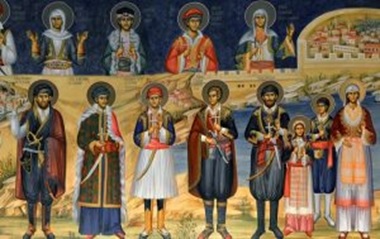The Blessing of the New Martyrs
11 May 2023Byzantium has accustomed us to honoring clergy and monks who were saints. Most of the new martyrs, however, were lay people, many of whom were poor, few were rich, some were illiterate, others were well-educated. This phenomenon takes us back to the early years of the Church, when the martyrs came from all social strata and were, by and large, lay people.
Another characteristic of the new martyrs is that they were ordinary people like us. They worked at everyday jobs and made a living from normal trades, which were often used as distinctive names. Thus we have Ioannis the skipper, Georgios the tailor, Mihaïl the gardener, Nikolaos the grocer and Triandafyllos the sailor. We also have merchants, goldsmiths, shepherds, painters, fishermen, grammarians, and overseers of Turkish land-holdings. The same is true of the female new martyrs, whose capacities and occupations varied.
 As regards age, the vast majority of new martyrs were young, some even between the ages of ten to fifteen. Some were married and lived with their spouses and children, while others hadn’t yet managed to start a family. One tragic case is that of Georgios, from Magnisia, who was betrothed and was martyred just a few days before his wedding.
As regards age, the vast majority of new martyrs were young, some even between the ages of ten to fifteen. Some were married and lived with their spouses and children, while others hadn’t yet managed to start a family. One tragic case is that of Georgios, from Magnisia, who was betrothed and was martyred just a few days before his wedding.
Of course, there’s no lack of monks, priests, bishops and patriarchs who also were martyred.
The iconographers painted the new martyrs in their everyday clothing: kilts, breeches, trousers, capes, poor headgear and traditional footwear. Icons of the new martyrs are important sources for research into the details of their lives.
The new martyrs weren’t ascetics, nor were they estranged from the world. Their jobs brought them into contact with everyone, Greeks and Turks. Some of them were even employed at the palace and others would occasionally share in entertainment with Turks.
Many of them are lauded by their biographers for the beauty of their outer appearance, which was often the cause of their martyrdom. These characterizations are always accompanied by references to their spiritual virtues, and mention is also made to their ‘orderly way of life’, the ‘education and edification by the Lord’ and ‘all modesty and moderation’. Their daily lives were no different from those of ordinary Christians, but mention is always made of their great love for the Church, their dedication to its liturgical life, their charity, simplicity and humility.
This information accentuates the great importance the host of new martyrs has for the Church. They call attention to the lay element in the body of the Church; they bridged the supposed gap between sanctity and everyday life; they taught and still teach Christians in all eras that temptation can arise at any moment; and they presented martyrdom not as the privilege of a few luminous, exceptional figures, but as the path we’re all called upon to tread, each in our own way.






